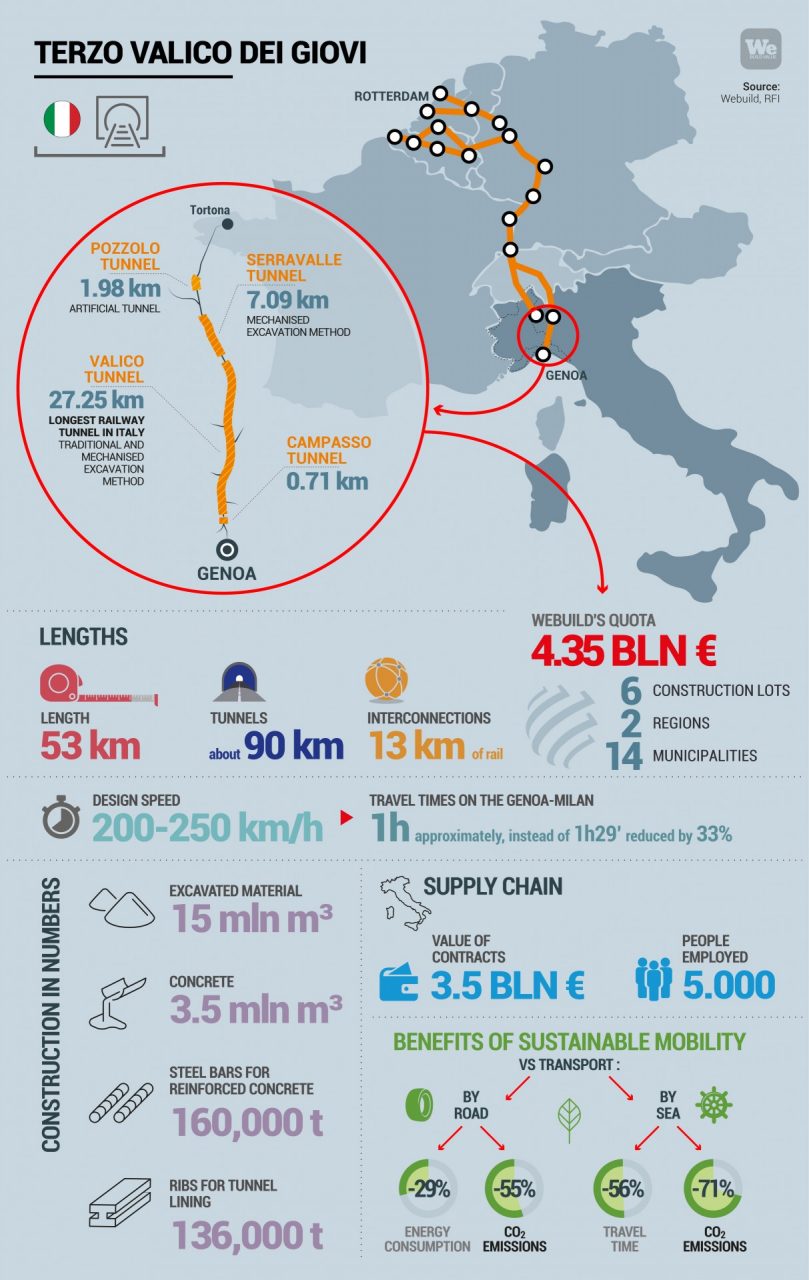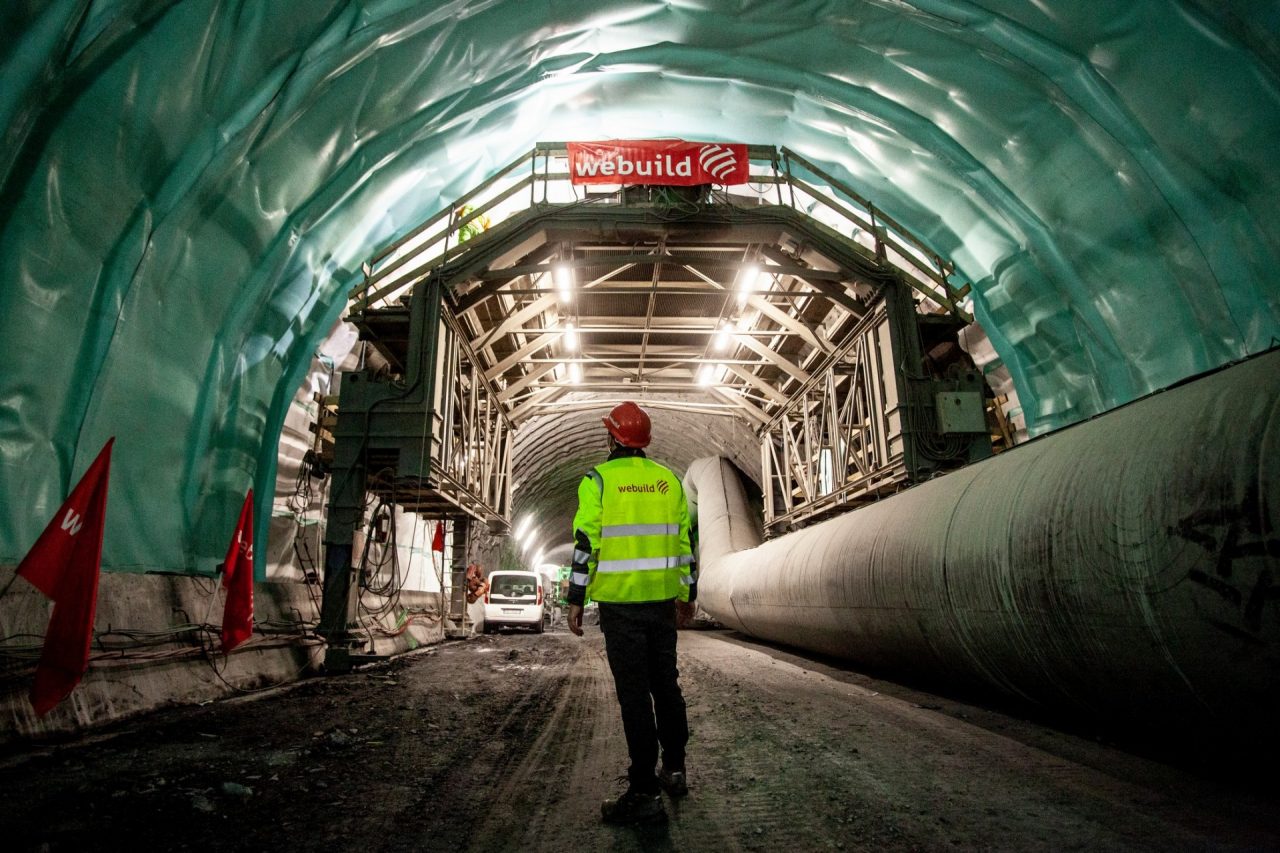Details of the Terzo Valico dei Giovi, the high-speed mountain pass connecting Genoa to Milan, are no longer being kept “in the dark,” though the underground portion of the route, some 23 of the 34 total miles (37/54 kms) certainly is. The above-tunnel gaps along the line stretch up to 1969 feet (600 meters) before reaching solid ground.
Factoring in all of the secondary and connecting lines, 56 miles (90 kms) of tunnels were constructed for this project. The numbers are impressive, and this high-speed Genoa-Milan railway line is set to become the longest railway tunnel in Italy. But this Webuild group project is also noteworthy for its techniques and measures to protect the environment.
Racing beneath the mountains
Excavation was central to the construction work carried out for the Terzo Valico dei Giovi. Of the 56 miles (90 kms) of tunnels carried out for the project, 17 miles (28 kms) were excavated by TBM (tunnel boring machines) and the remaining 39 miles (56 kms) with traditional methods.
The TBMs were equipped with cutter heads designed specifically for the ground’s unique characteristics. More traditional methods, primarily demolition hammers and explosives, were used on the remaining portions.
Traditional methods were key under the Ligurian mountains in particular, due to their poorer composition, which ruled out the use of TBM.
As excavation processes progressed, proper management of materials was a recurring problem across sites. In response, innovative solutions were implemented. Among these was a conveyor belt system that could efficiently load inert waste and transport it to storage facilities. The Cravasco site, which handled one million cubic meters (35 million cubic feet) of materials, introduced a 1.2 mile (2 kilometer) conveyor belt system that could transport up to 800 tons per hour. Due to the mountainous nature of the terrain, an 853-feet 8260 metre) portion of this conveyor belt system was suspended in the air, 30 feet (9 metres) above the ground. This “flying belt” facilitated connection between the construction site and the quarry.
Protecting workers from asbestos
When working underground, unexpected discoveries are part and parcel of the daily routine. All the Terzo Valico tunnels pass through a highly complex geological-structural environment that has produced more than a few surprises. The most challenging of these was asbestos in its natural state, uncovered during the excavation process.
The presence of asbestos required reorganising work methods and the order of business. First on the priority list was identifying the sources of asbestos fibers emission by calculating their spread in the air, water, and, of course, the ground. A sophisticated suction ventilation system was quickly installed to protect workers. The system had two key functions: absorbing the maximum amount possible of all fibers released during rock demolition and felling, and replenishing the tunnels with clean air sourced from the outside.
In addition to this air recirculation system, large de-pollution units were installed to filter the asbestos. All work areas and the tunnels themselves have been “compartmentalised” – isolated from the rest of the mountain – thereby minimising contact with any asbestos fiber-contaminated areas.
Decontamination areas were also created for personnel and vehicles, equipped with changing rooms, showers, and air extraction systems.
Water from the excavation tunnels that contained asbestos fibers was pumped into treatment plants, filtered, and then purified.
Sustainability in excavation material management
Given that the Terzo Valico’s construction sites are so spread out, opportunities to make more sustainable choices abound, particularly in how excavation materials are managed.
Webuild Group, which is overseeing the project, has partnered with Milan’s IRCSS “Mario Negri”, the Politecnico of Turin and with the University of Genoa, which have developed ecotoxicological studies to establish threshold values determining when the excavated material can be reused.
Consequently, all material extracted from tunnel construction underwent controls and analyses to ensure it met standards enacted to protect human health and the environment. At the “Romanellotta” site, for example, a spacious, open-air, 1,614,587 square foot (150,000 square metres) deposit was set up. Excavated materials were temporarily collected, then arranged in piles no more than 3 feet (one metre) high, and rotated from time to time to ensure proper oxygenation. Members of the Department of Chemistry at the University of Genoa then chemically analyzed each pile. Once treatment was complete, the materials were delivered to their final sites – former mines, newly filled and re-naturalized – bringing them back to their agricultural and naturalistic places of origin.
From the excavated materials, then, new green hills will came about. The natural landscape will be newly enhanced when the line is finished, and travelers able to admire it from the train windows.
Genoa railway junction, the last mile of a crucial project
In order to fully understand the impact and scope of a strategic infrastructure project like the Genoa-Milan high capacity rail link, it is necessary to focus on those kilometres inside the city limits that will connect the link to Genoa’s. This is the all-important “last mile” of the entire project.
The Genoa Railway Node, which has been awarded to the Webuild group, calls for adding new track to existing lines, adapting and upgrading them. The goal is to separate traffic flows of long-distance trains from those of the regional and metropolitan service.
In essence, the railway node will mean setting up a “fast track” on rail for goods that arrive at the port of Genoa and are destined for export to Europe, headed directly north on the tracks of the high-speed railway of Terzo Valico.
Like the Terzo Valico, the Railway Node will also run mainly underground. The project involves the construction of three tunnels: the Nuova San Tomaso, 1,500-meter-long (0.9 mile) single-track tunnel; the 1,409-meter-long (0.8 mile) Nuova Cristoforo Colombo; and the last, the 2,167-meter-long (1.3-mile) Polcevera Tunnel. The tunnels will make it possible to extend the high-speed line right into to the heart of the Ligurian capital, on the one hand making city transport more efficient and integrated, and on the other acting as a development lever for the port of Genoa.



